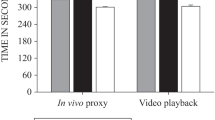Abstract
Recording and analyzing real-time interactions in clinical settings is important for basic and applied research in psychology and other disciplines. Investigators frequently have used simple audiotaping procedures to record these encounters (e.g., Roter, Geller, Bernhardt, Larson, & Doksum, 1999), but videorecording is increasingly viewed as more reliable and valid, because it captures the full range of complex and interdependent verbal and nonverbal behaviors that occur in an interaction. This article describes a system designed to videotape clinical interactions in a manner that can be moved in and out of different clinical rooms to preserve flexibility in its use. Data are presented to demonstrate that the system is unobtrusive during the interaction, yet fully compatible with institutional review board guidelines to protect human participants’ privacy and freedom to control the recording process.
Similar content being viewed by others
References
Bavelas, J. B. (1994). Gestures as part of speech: Methodological implications.Research on Language & Social Interaction,27, 201–221.
Bavelas, J. B., Chovil, N., Coates, L., &Roe, L. (1995). Gestures specialized for dialogue.Personality & Social Psychology Bulletin,21, 394–405.
The Belmont Report: Ethical principles and guidelines for the protection of human subjects of research (1979, April 18). Bethesda, MD: Office of Human Subjects Research.
Burgoon, J. (1994). Nonverbal signals. In M. N. Knapp & G. R. Miller (Eds.),Handbook of interpersonal communication (2nd ed., pp. 229–285). Thousand Oaks, CA: Sage.
Ford, S., Hall, A., Ratcliffe, D., &Fallowfield, L. (2000). The Medical Interaction Process System (MIPS): An instrument for analyzing interviews of oncologists and patients with cancer.Social Science & Medicine,50, 553–566.
Ickes, W. (1994). Methods of studying close relationships. In A. Weber & J. Harvey (Eds.),Perspectives on close relationships (pp. 18–44). Boston: Allyn & Bacon.
Ickes, W., &Tooke, W. (1988). The observational method: Studying the interaction of minds and bodies. In S. Duck & S. Hay (Eds.),Handbook of personal relationships: Theory, research, and interventions (pp. 79–97). Chichester, U.K.: Wiley.
Jones, S. E., &LeBaron, C. D. (2002). Guest editors’ introduction.Journal of Communication,52, 499–522.
Nuremberg Code (1949). InTrials of war criminals before the Nuremberg Military Tribunals under Control Council Law No. 10, Vol. 2 (pp. 181–182). Washington, DC: U.S. Government Printing Office.
Riddle, D. L., Albrecht, T. L., Coovert, M. D., Penner, L. A., Ruckdeschel, J. C., Blanchard, C. G., Urbizu, D., &Quinn, G. (2002). Differences in audiotaped versus videotaped physician-patient interactions.Journal of Nonverbal Behavior,26, 219–240.
Roter, D. L., Geller, G., Bernhardt, B. A., Larson, S. M., &Doksum, T. (1999). Effects of obstetrician gender on communication and patient satisfaction.Obstetrics & Gynecology,93, 635–641.
Author information
Authors and Affiliations
Corresponding author
Additional information
This project has been funded by Grant 5 R01 CA75003-A3 from the National Cancer Center/National Institutes of Health to T.L.A.
Note—This article was accepted by the previous editor, Jonathan Vaughan.
Rights and permissions
About this article
Cite this article
Albrecht, T.L., Ruckdeschel, J.C., Ray, F.L. et al. A portable, unobtrusive device for videorecording clinical interactions. Behavior Research Methods 37, 165–169 (2005). https://doi.org/10.3758/BF03206411
Received:
Accepted:
Published:
Issue Date:
DOI: https://doi.org/10.3758/BF03206411




